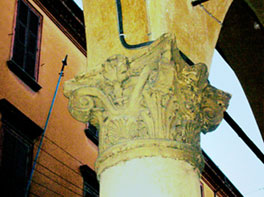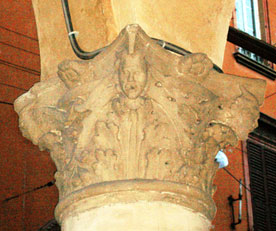|
BED AND BREAKFAST IN BOLOGNA ACCOMMODATION IN BOLOGNA ERBORISTERIA WEBMASTER |
||||||
|
|
In the 15th Century the powerful Bentivoglio family tried
to put into practice aristocratic-bourgeois (Florentine) individualism, by
beautifying the town with buildings which only interested the highest
social class, hence ignoring the portico community. The first man who really held power in Bologna
was Sante Bentivoglio (the Bentivoglio family would draw inspiration from
the Sforza of Milan and the Medici of Florence); he
was educated in Florence and, in 1460, he
ordered1he building of a great palace, the project by Lapo Portigiani da
Fiesole, in the area which would be later occupied, but only part of it,
by the present Municipal Theatre; a building comparable to the Florentine
Medici Palace. At the beginning of the following century, when the
Bentivoglio domination came to an end, this palace was destroyed by mob
violence (in piazza Verdi only the stables remain which were in front of
it). In the following years the Bolognese Renaissance began and reached
its maximal glory during the reign of Giovanni II
Bentivoglio (1463-1507). Giovanni, with his wife Ginevra Sforza, were able
to keep peace in the town for 40 years, sometimes with violence, and start
the Bolognese Renaissance; and this was because an oligarchic power had
been restored with the institution of a Senate made up of the noble
land-owners, the nouveau-riches and the new papal and imperial nobility.
The town which already had its own character was made more beautiful
by"demolitions", which created squares and open areas and, above all,
clearly showed how the straight Via Emilia stretched rightly through the
town; the many streams, sources of energy for the silk, hemp and paper
industries were controlled; agriculture was implemented and the
countryside was linked with the town by means of a canal reaching the
"Porto Naviglio" from Corticella; at the same time
noble mansions and bourgeois houses were built and the facades
of the churches rennovated. |
|
b u |
|||
|
General - Environment - Iron and Etruscan Age - Roman Age - Patron Saint- The Commune - Alma mater studiorum - Re Enzo - Porticoes - St Peter - Gothic - 14th Century - Piazza Maggiore - Aristocratic palaces - Brick and other stones - Early 15th Century - Archiginnasio - Counter Reformation Renaissance - 16th Century - Great portico ribbons - Frescoes in palaces - The "scenographic" city - Napoleon's republics - Fall of Church power - The Restoration - Haussmann style - The new Century - Floreal style - Rationalism - World War - Active preservation - Around 2000 |
||||||

